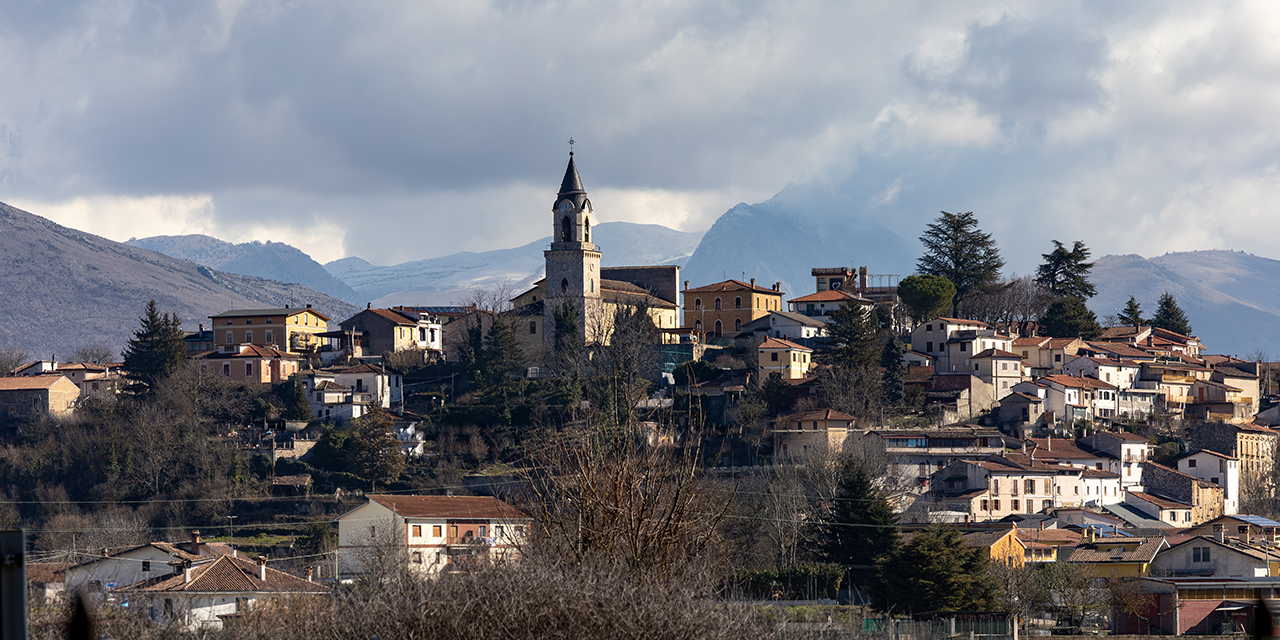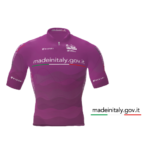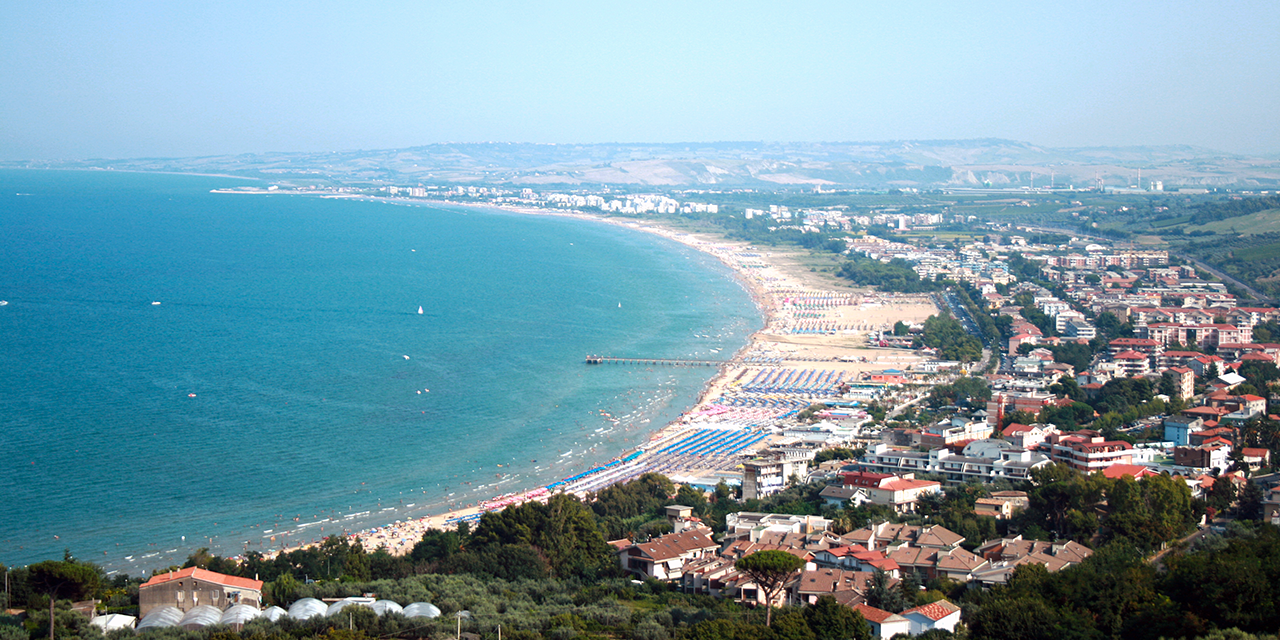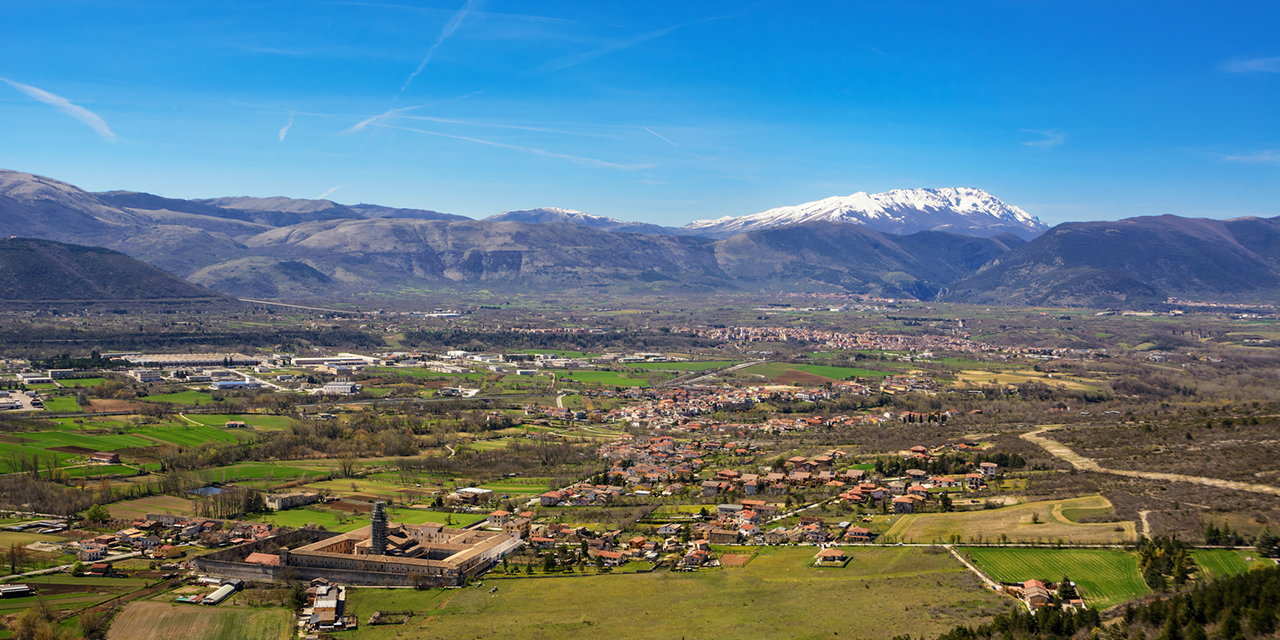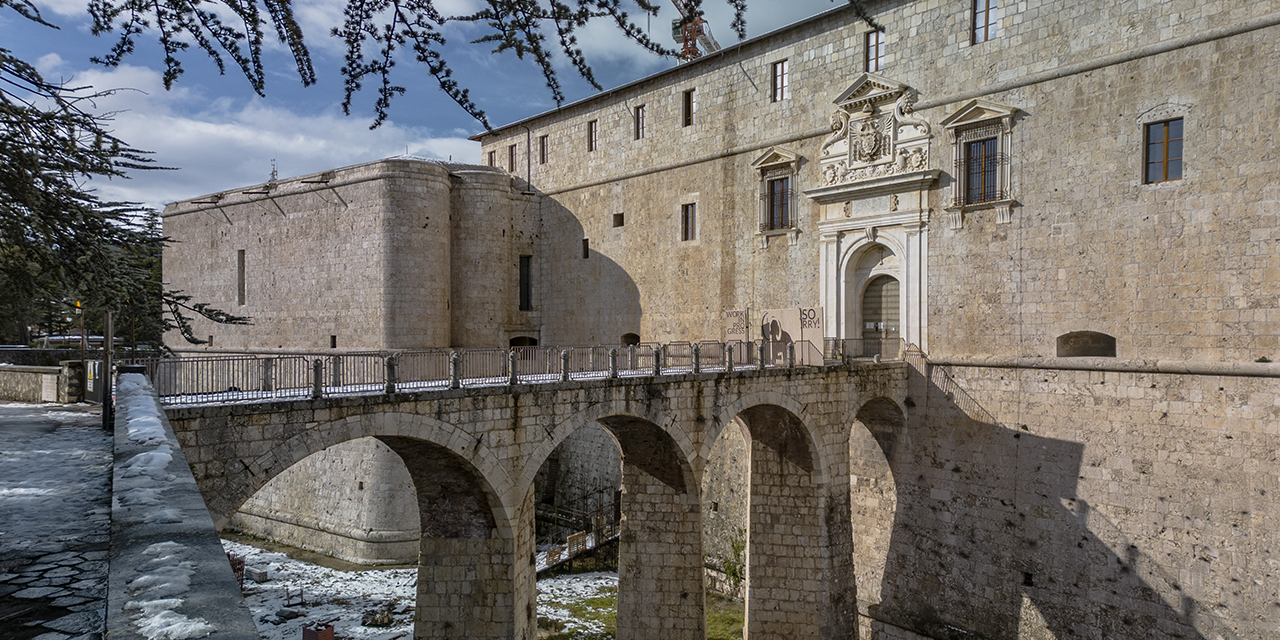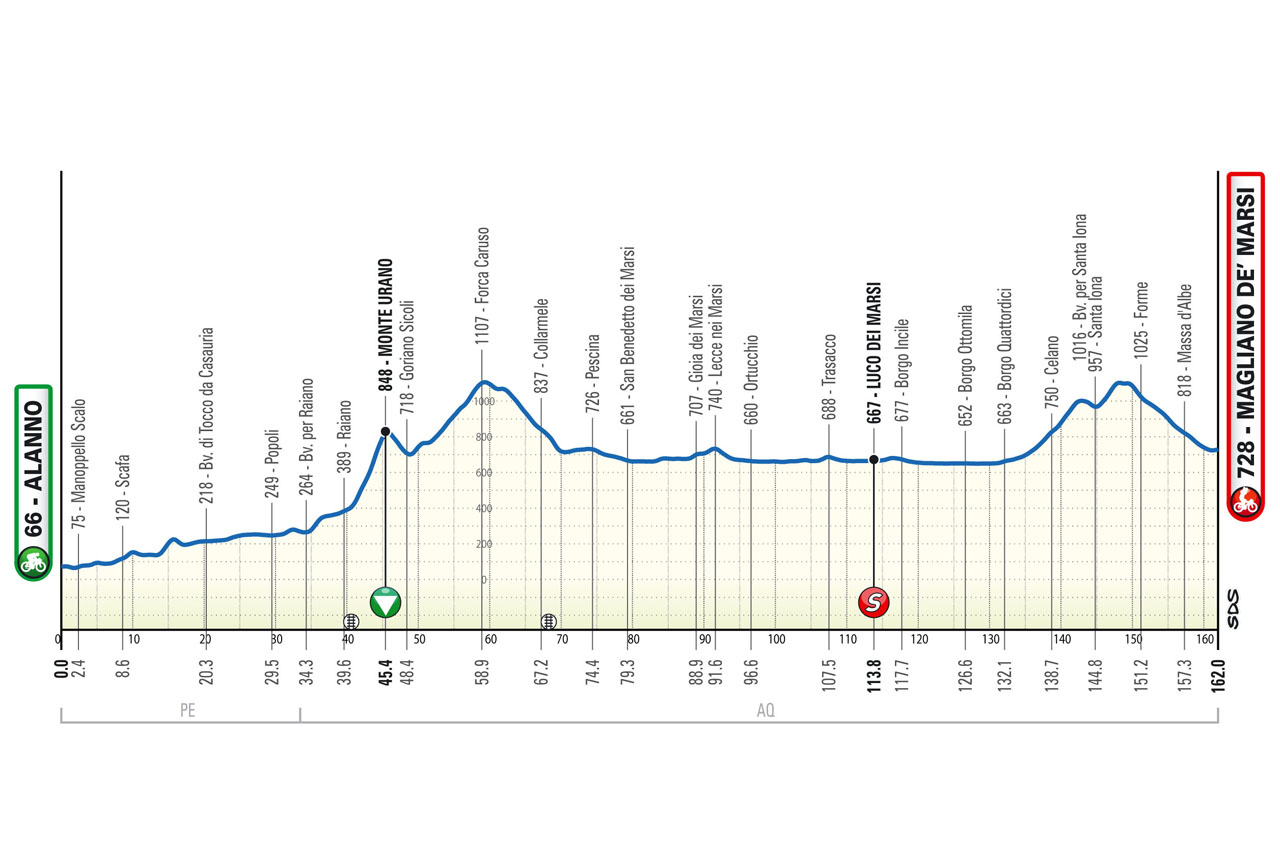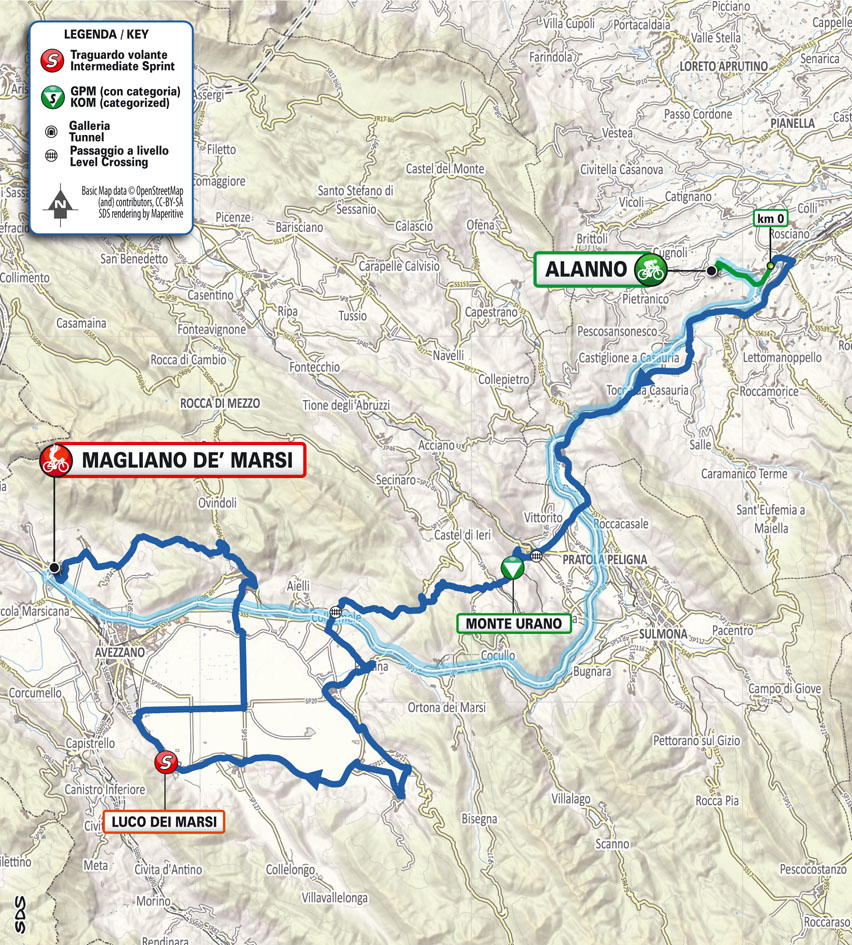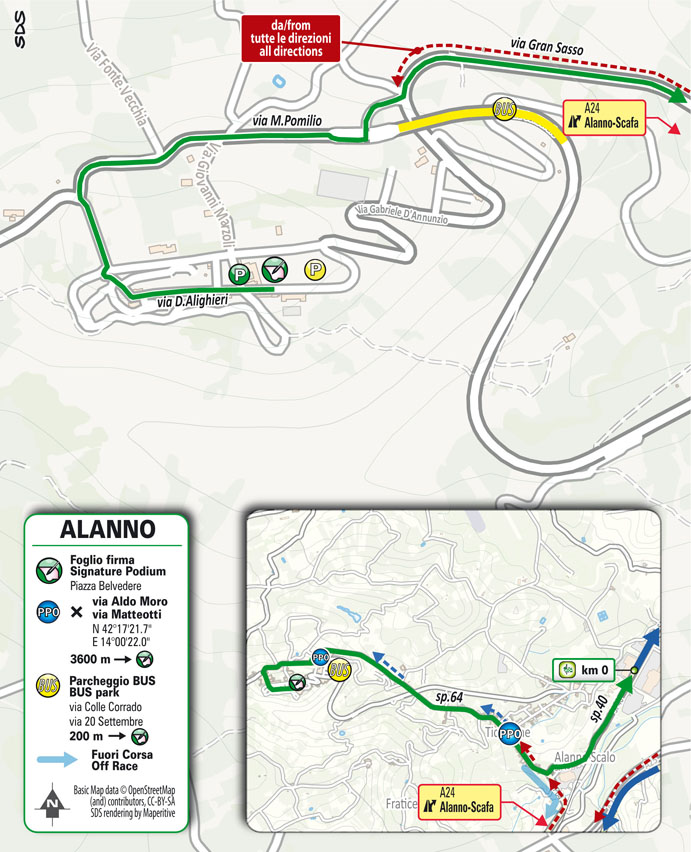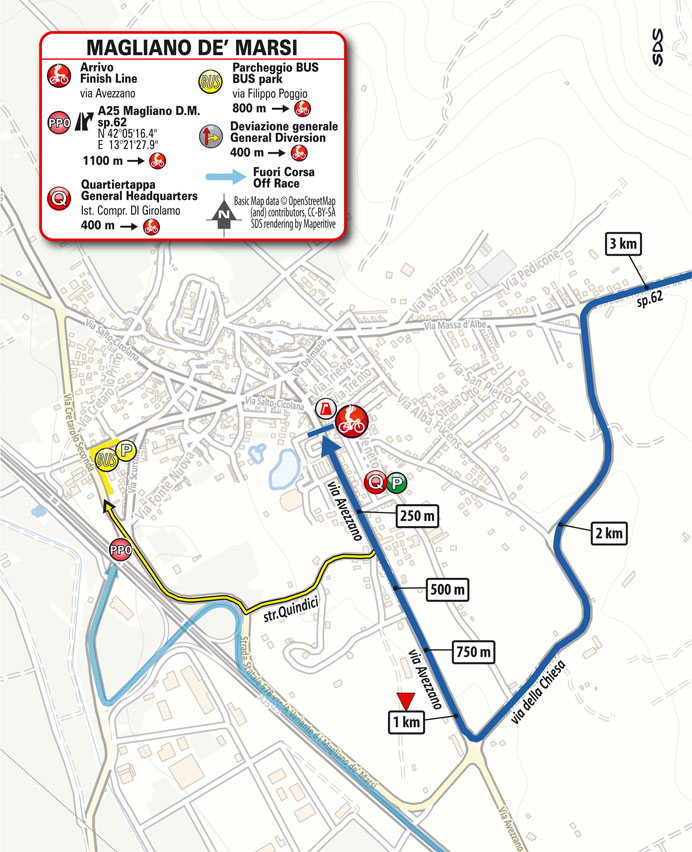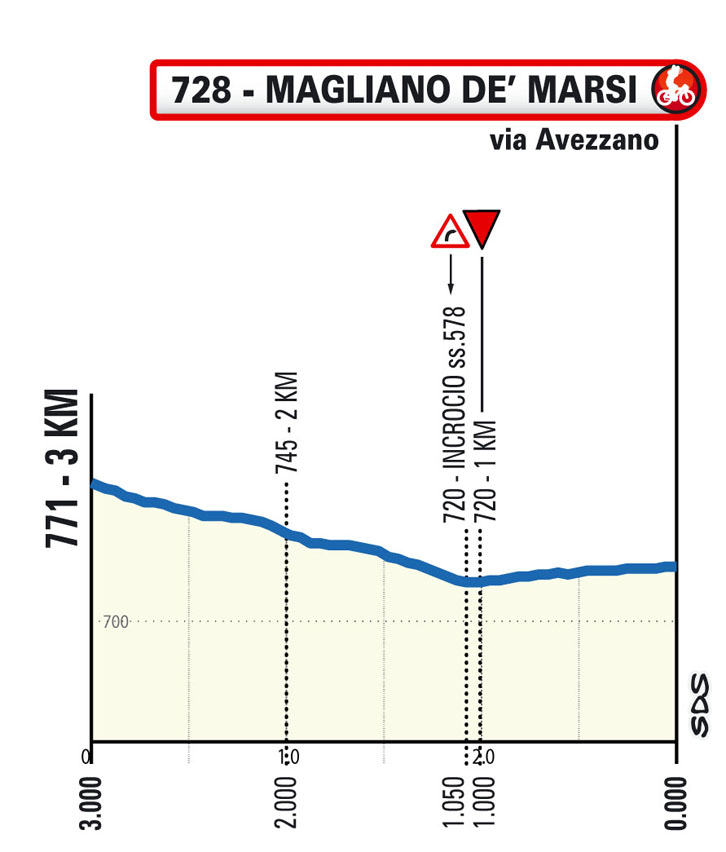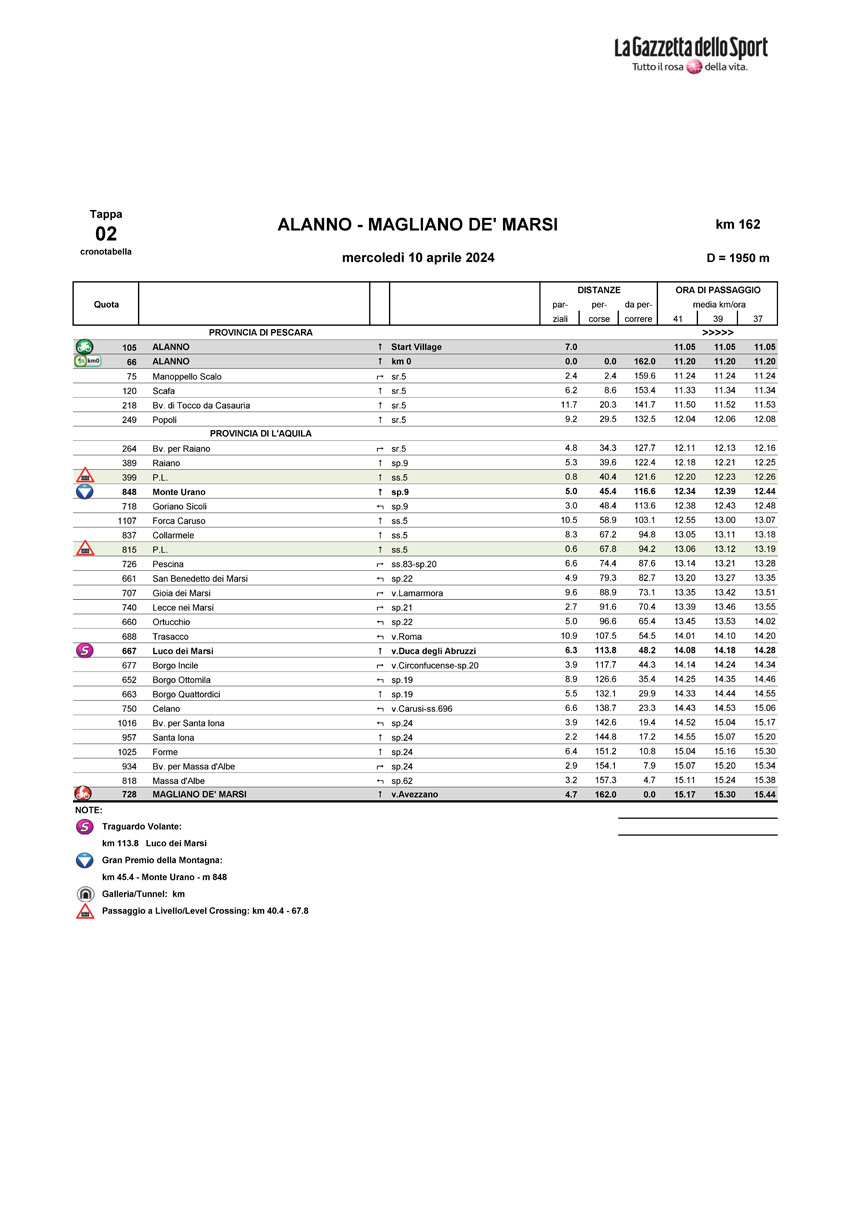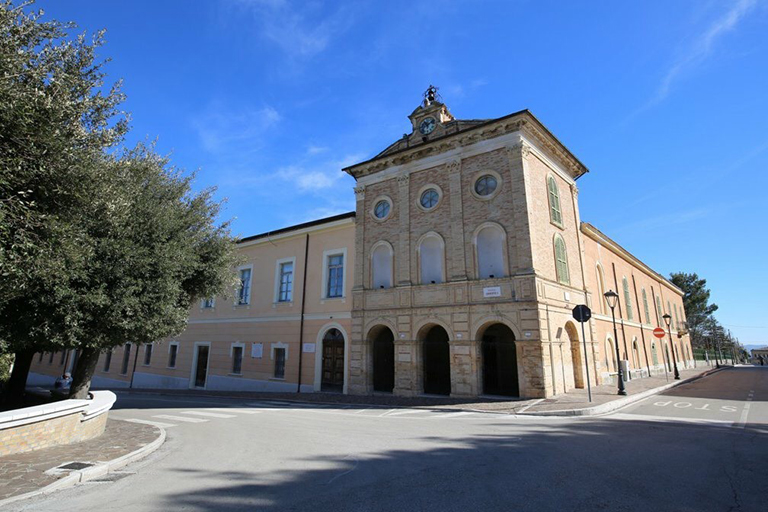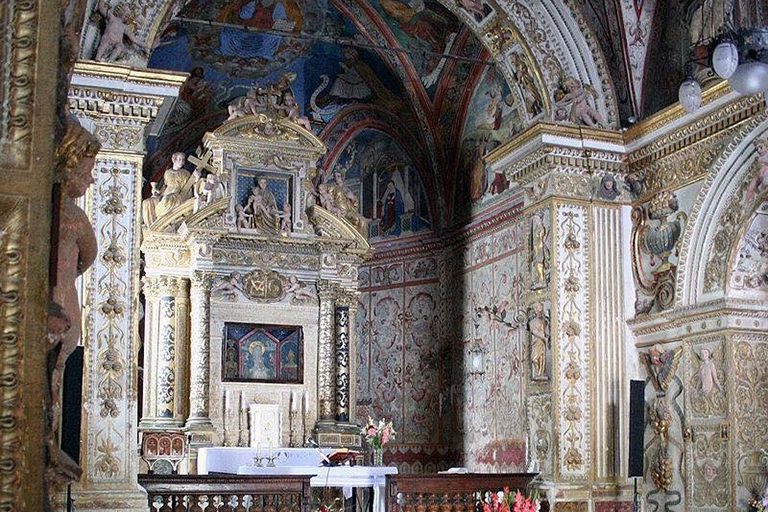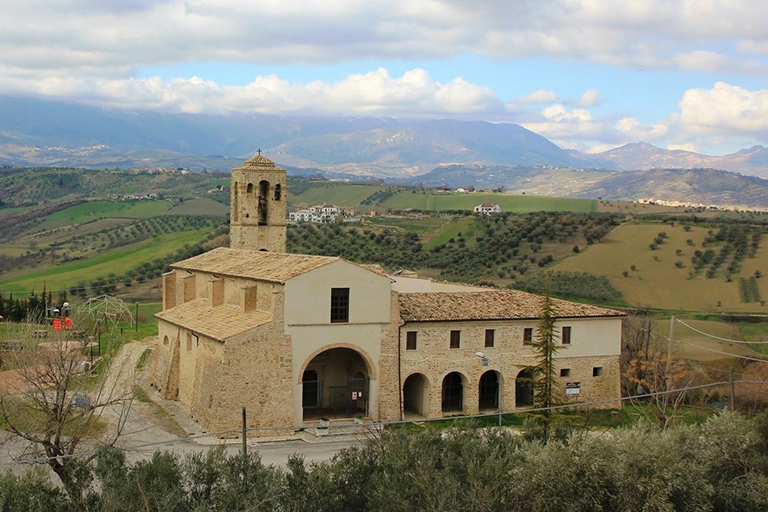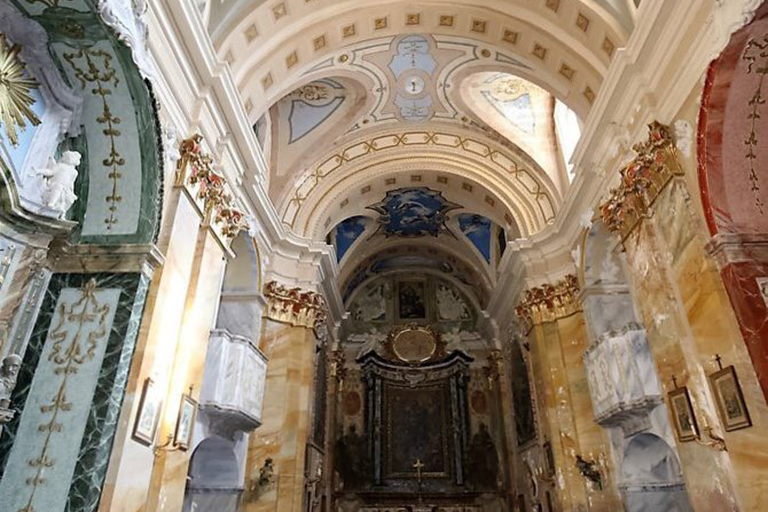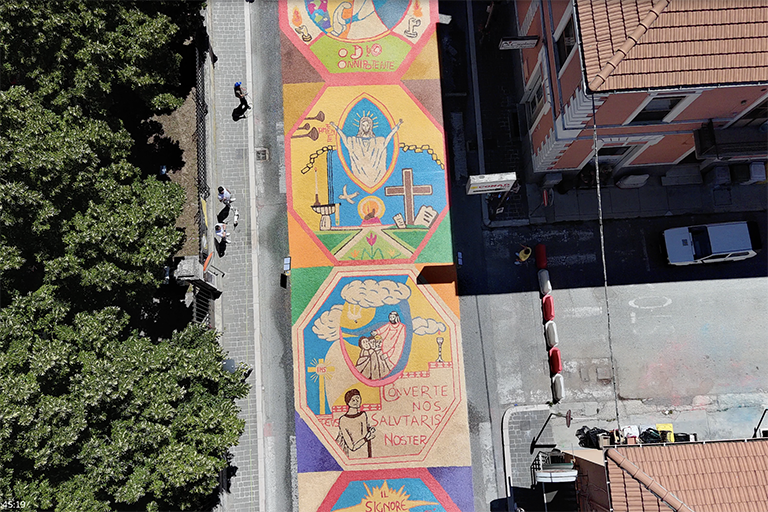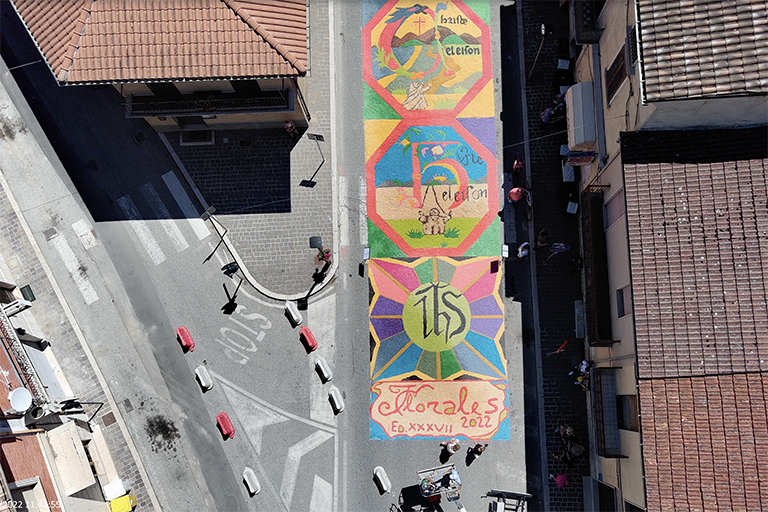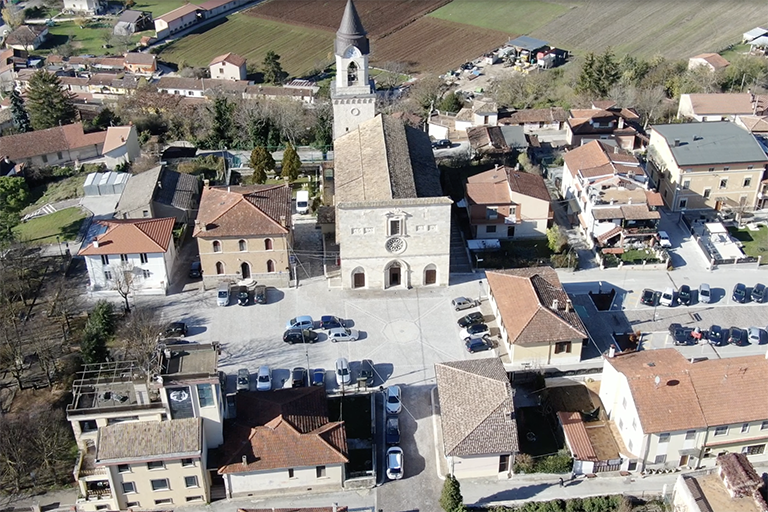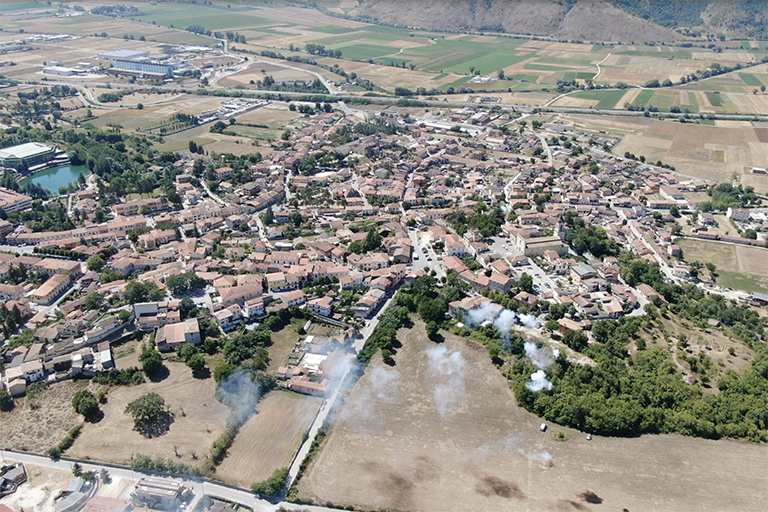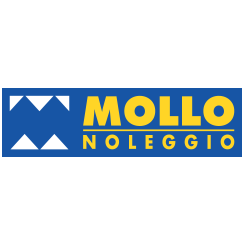profile
map
technical info
The stage starts and finishes with a climb. The riders will first tackle Monte Urano, then cover 60 flat km along the Piana del Fucino plain before facing the Forca Caruso climb. The roads are flat and straight, with the usual traffic obstacles in the urban centres. The town of Celano marks the beginning of the final climb to Santa Iona-Forme, followed by the descent towards the finish line.
Last km
The last 3 km are slightly uphill and perfectly straight. The final straight is 1100 m long (8 m wide) on asphalt.
start / finish
final kilometres
itinerary timetable
tourist info
Host city:
ALANNO
Overview
The name of Alanno originates from the Lombards and dates back to the seventh century, located on the hills of Pescara. Its territory consists of 12 districts, surrounded by the mountains of “Morrone” and “Maiella”, which, along with the “Bella Addormentata”, merge into the “Gran Sasso”. In the upper part of the town lies the Medieval Village with its 14th-century towers, along with the Agricultural Institute built on an ancient Franciscan convent. Visitors can also admire the ancient “rue,” narrow streets that cross the main street on both sides. In the main square of Alanno we have a solitary tower that dominates the square; it was part of the Palace of Marcantonio Leoniani Fieramosca.
Local Cusine
Alanno is famous for restaurants where tourists can be eat a typical dishes like: “Sagne e fagioli”, ‘Li pittilun’ with onion, pecorino cheese and tomatoes, then we can enjoy the ‘Chitarra al ragù’, ‘L’oss d’lu parent’ a pork meat, and the last but not least the ‘Arrosticini’. For what concerne the desserts we can eat ‘Pizzelle’ ( neole in dialect) with grape jam, the ‘Sfogliatelle’ and ‘Chiacchiere’.
Alanno is important as well as for the production of extra virgin olive oil with distinctive fragrances and local varieties.
Wine and other drinks
Alanno with the beautiful sunshine (la solagne), have a significant olive groves and vineyards such as Montepulciano D’Abruzzo, Cerasuolo, Trebbiano d’Abruzzo, Pecorino e Cococciola.
Points of interest
CHIESA DI SAN FRANCESCO E DI SAN LUDOVICO
This church is close to the Franciscan Convent. The Church and the Convent were restored in 1575. They suffered significant damage from the earthquake of 1915 and were restored again, in particular way the interior paintings by the Franciscan painter Father Giovanni Lerario. Noteworthy are the paintings by Ranieri da Guardiagrele from 1794 and the beautiful painting of the “Madonna Immacolata” by the painter Paolus De Maio.
LE TORRI.
A defencive medieval circular tower connected by walls to other round and square towers, dating back to the late 1300s and early 1400s.
PALAZZO DELLE SCUOLE
This palace was built in 1922. At first was the headquarters of the Primary school, and then of the Middle schools, and today it represents the most beautiful school in our country.
PIAZZA DEL BORGO.
This square is one of the most important neighborhoods of Alanno. It’s an area formed by ancient gates that allowed entry into the town, such as Porta San Francesco and Porta San Giovanni. A typical small square arises in the midst of the houses with flowers and benches.
CASA DELLA CULTURA GABRIELE D’ANNUNZIO. This building was the first Municipal Palace built in the first half of the 1800s. In the early 1900s the Municipality bought the Fieramosca Palace. In this Palace in 1927 the Franciscan Sisters were hosted, who founded the nursery. They remained in Alanno until 1994. Today the Palace has become the House of Culture hosting the municipal library and a small museum.
The church of the ORATORIO DELLA MADONNA DELLE GRAZIE was built in XV – XVI century. The story tells about of an Apparition of the Madonna to a man who was tending to his oxen near an old church, and she asked him to clean her house. The church was completed in 1505, as evidenced by the inscription on the entrance portal. The portal is made in Maiella stone by work of Giacomo Di Silvestro from Sulmona. The style of the church is simple Romanesque, but inside, we can find a treasure. The interiors, created by Donato Perada and completed in 1675, are highly significant. The twelve statues depicting prophets and kings of the Old Testament are particularly important. Another element of great interest is the 12 sibyls painted on the sail vault of the nave. The frescoes above the apse date back to 1522 and are attributed to the school of Andrea De Litio, depicting scenes from the life of the Madonna. A great painting by Bernardino Caporale from 1698, depicting the Assumption of Mary with angels is situated behind the altar. The altar, completed in 1642, features a precious triptych with the Madonna between Saint Sebastian and a Holy Pope.
MAGLIANO DE' MARSI
Overview
Magliano de’ Marsi stands on three small hills protected by the majestic heights of mt. Velino end surrounded by wildlife. Its beauty tells us about the strength end tenacity of its ancient inhabitants.
About four thousand people inhabit Magliano de’ Marsi end its two hamlets, Rosciolo and Marano. Its name is mentioned for the first time, in an ancient document (1250) about the income of Santa Maria in Valle Porclaneta church, where there is a clear reference to a church of Santa Maria in Magliano de’ Marsi.
In earlier times the village wasn’t an independent caste because it belonged to carce, a major center whose name, little by little began to lose importance until it disappeared in the XV century.
In the XVI century the new church of Santa Lucia in Magliano took the place of the ancient parish church of San Martino in carce.
In the XVII century, Magliano rapidly developed, and its population increased and almost doubled in fifty years. In 1860, Magliano was involved in risorgimental affairs after having voted in favour of the house of Savoy and Italian unity. For this reason, the village risked an attack and a sack by the French army led by the general La Grange, sent by house of Bourbon. This happened between 19 and 20 of october.
Tradition tells us that Magliano was saved thanks to the intercession of its patron saints John and Paul (two roman soldiers) and St. Lucy. Now days local people remember this event every year on 20 of October celebrating it by doing a procession an a historical commemoration. Two violent earthquakes (1904 and 1915) devasted the village and 621 people died. The parish church collapsed only the bell tower, didn’t fall down. It was designed by Tommaso Di Lorenzo and built in 1880. Although subsequent events due to Italy joining the first world war, the inhabitants of Magliano rebuilt their village and 22 years later their church, symbol of their faith was rebuilt and the first holy mass was celebrated on Christmas night, 1937.
Local Cusine
Our territory offers not only art and beauty, but also gastronomic specialties based on a natural products as the ones growing on our hills: orapi (wild spinach), truffles and mushrooms.
In our fields a rare variety of maize, known as “eight row” is cultivated. It shows fight rows of amber-coloured grains.
Our broccoli are well-known because they are different from the ones cultivated in other areas thanks to climatic condition and a fertile soil. Saffron plantation are becoming more and more popular.
Our typical dishes are prepared following old recipies, so you can taste boar stew and “pecora ajo cotturo” (boiled sheep meat seasoned with aromatic herbs and spicies).
Before lake Fucino was drained (1878) the climatic conditions allowed the growing of a native vine from which aleatico wine and malmsey could be obtained. It was also possible to brew a very light wine called “abbottautti”.
Points of interests
Testimonies of an artistic past can be seen in Magliano and in its hamlets were the wildlife, protected by the regional natural park Sirente-Velino, can offer tourist attractions, too.
The most important building is Santa Lucia church built between XIII and XIV century, probably by the same workers who had just built the church of Santa Maria Della Vittoria in Scurcola Marsicana.
The lower part of the facade (XII century) as got three pointed arched portals; the higher part is decorated with a rosewindow (XV century) and a large baroque window.
On both sides of this window you can see four plutei, one of which quotes the well-known words “sator-arepo-tenet-opera-rotas”.
The interior of the church is divided into a nave and two side aisles, and you can see a pulpit made by medieval and renaissance architectural artefacts.
An XVIII century fresco is painted on its frontal side, representing Santa Apollonia.
The left and the right side of the presbytery is surrounded by an ancient and well-crafted wooden choir, coming from the San Martino Friary in carce, completely destroyed by earthquake, in 1915.
Important frescos can also be found in the other three churches: Santa Maria di Loreto Church, San Domenico church and a small memorial chapel dedicated to the soldiers killed in the first and second world war.
Santa Lucia church is surrounded by a ring-shaped street named “Tornoterra” where from epiphany to carnival day it is possible to play “Cheese”. Players throw cheese wheels and make then roll along the way.
The same cheese is used to make good easter cakes called “fiatoni”.
Along this street can still see an ancient chaplaincy consecrated to St. Blaise, a very war shipped saint, invoked for protection against illness of the throat.
A holy mass is celebrated, every years on the third of February, in his honor during which the priest blesses the “chiortani” special doughnuts dedicated to him.
Once a year, the feast of “infiorata” attracts lots of onlookers and foreign tourists. It takes place in the main street of Magliano (about 200 and 50 meters long) and celebrates the feast of “Corpus Domini”. The night before, the street is divided into 24 squares and people start drawing sketches. Soon after they begin the realization of the pictures with flowers, coloured wood shavings and natural seeds.
It is quite an impressive view that never fails to amaze.
If you visit Marano you can see the church of the assumption, built between X and XI century, dedicated to St. John and St. Paul, whose cult began when their relics were brought from Rome. The structure of the church has fallen into decay by natural causes, but we can still see on a wall an interesting painting cycle dated X-XI century and a baroque fresco representing two martyrs in the heavenly glory. The church had been visited since ancient times by large numbers of pilgrims who engraved lots of crosses on the main portal.
Rosciolo is developed around its main church, Santa Maria delle Grazie, but you can also visit the church of San Sebastiano, the church of Santa Barnaba and above all the church of Santa Maria in Valle Porclaneta, an artistic jem set like a precious stone in an untouched countryside. This church was built in the XIX century by Benedictine monks.
Its roof with its two sloping pitches, follows the natural sides of Mont Velino rising on the background.


